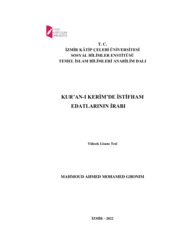Kur’an-ı Kerim’de istifham edatlarının irabı The revelation of prepositions of resignation in the Qur'an
-
Eser Sahibi
Ghonim, Mahmoud Ahmed Mohamed
- Tez Danışmanı Necla Yasdıman Demirdöven
-
Tür
Yüksek Lisans
- Yayın Tarihi 2022
-
Yayıncı
İzmir Katip Çelebi Üniversitesi Sosyal Bilimler Enstitüsü
- Tek Biçim Adres https://hdl.handle.net/11469/2979
-
Konu Başlıkları
Arap dili - Dil bilgisi
Arabic language - Grammar
ÖZETİnsanın iki özelliği vardır, birisi düşünce diğeri ise beyandır. Bu beyanın anahtarı kelimedir
kelimeye mana veren faktör de cümledir. Cümleye ise düzen veren ilim dalı irâb ilmidir. İrabın tarihi, zaten dilin olgunluk tarihiyle başlamıştır. Bu sistemi kuran da dil âlimleri olmuştur. Başta el-Halîl, Sîbeveyhi, el-Kisâî, el-Ferrâ, ez-Zeccâc gibi büyük dil âlimleridir. Gaye Cenabı Allah’ın kitabına hizmette bulunmaktır. Ayrıca Kur’an tefsiri eserlerindeki bu irâb metodu günümüze kadar devam etmektedir. Görevimiz ise bu irâb metodunu geniş bir şekilde bir bütün olarak sunmaktır. Bu tez çalışması bir giriş ve iki bölümden oluşmaktadır. Girişte, birinci başlığın altında irâb kavramı, ikinci başlığın altında irâb ve mana alakası, üçüncü başlığın altında irâbın tefsir, hadis, fıkıh gibi İslami ilimlerle ilişkisi, dördüncü ve son başlığı altında irâbın tarihteki örnekleri (mütekaddim, müte’ahhir ve muasır) ve öne çıkan metotları gözden geçirilmiştir. Birinci bölümde, İstifham ve edatlarının kavramı, hakiki ve mecâzi farklı manaları çeşitli örneklerle detaylı bir biçimde üzerinde durulmuştur. İkinci bölümde, İstifhamın Kur’an-ı Kerimdeki en bariz örneklerinin irâbı, dil âlimlerinin farklı görüşlerini de sunarak geniş bir şekilde kaleme alınmıştır. Sonuçta da istifham edatlarının dil ve İslami ilimlerdeki özelikle tefsir dalındaki önemine ve ehemmiyetine vurgu özet olarak yapılmıştır.ABSTRACTMan has two characteristics, one is thought and the other is statement. The key word in this statement is
The factor that gives meaning to the word is the sentence. The branch of science that gives order to the sentence is the science of Irab. The history of Irab has already started with the very first date of the language. It was the language scholars who established this system. First of all, they are great language scholars such as al-Khalîl, Sîbeveyhi, el-Kisâî, al-Ferrâ and ez-Zeccâc. The purpose is to serve the book of Allah Almighty. In addition, this method of Irab in the works of Quran’s commentary continues until today. Our task is to present this Irab method as a whole in a broad way. This thesis consists of an introduction and two parts. In the introduction, under the first title, the concept of irab, under the second title, its relation to irab and meaning, under the third title, the relationship of irab with Islamic sciences such as tafsir, hadith, and fiqh, and under the fourth and final title, examples of irab in history (mutekaddim, mut'ahhir and contemporary) and prominent methods were also reviewed. In the first part, the concept of istifham and its prepositions are discussed in detail with different real and figurative meanings with various examples. In the second part, the irab of the most obvious examples of istifham in the Qur'an has been extensively written by presenting the different views of language scholars. In conclusion, the importance of the prepositions of istifham in language and Islamic sciences, especially in the branch of tafsir, has been briefly emphasized.
-
Koleksiyonlar
ENSTİTÜLER
SOSYAL BİLİMLER ENSTİTÜSÜ

 Tam Metin
Tam Metin

